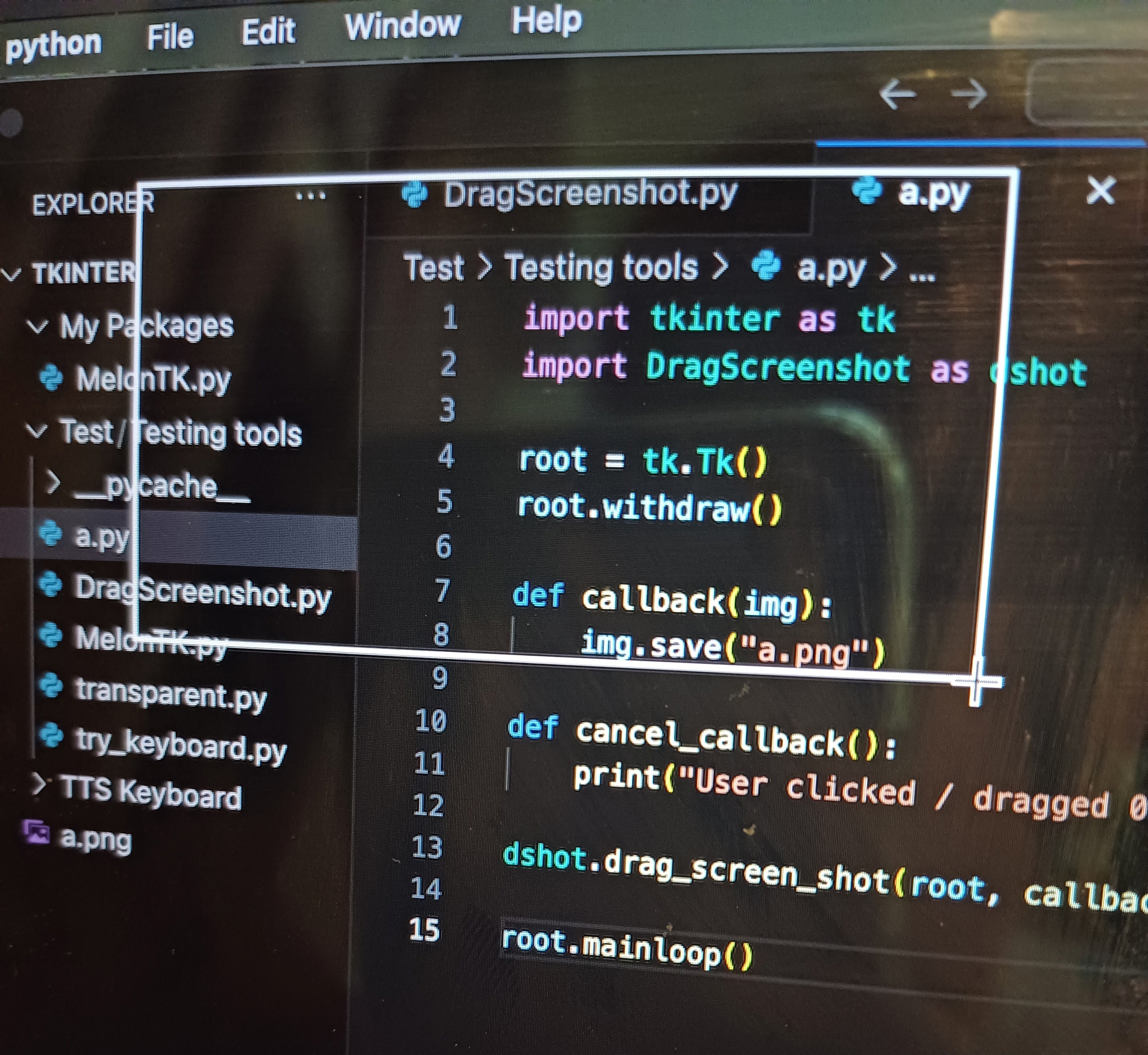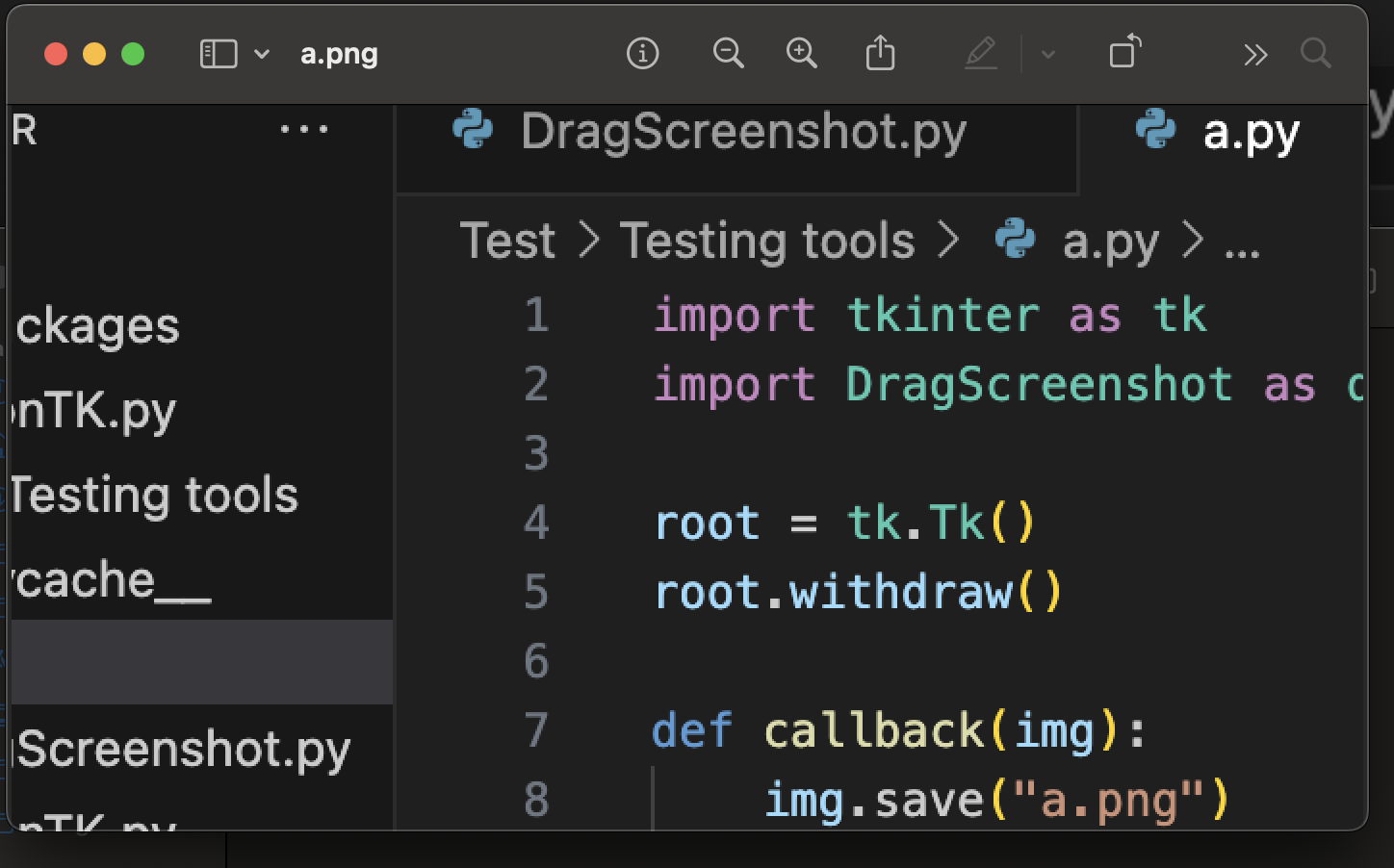I solved this problem by drawing on a transparent layer. This will allow the user to see through the invisible drawing layer and provide a surface for drawing the snipping box. When the user releases the snipping box functionality, it will destroy the invisible layer and capture the box coordinates. It will then take a screen shot within the captured coordinates and create + save this time stamped image to a directory called "snips" (feel free to adjust this).
from tkinter import *
import pyautogui
import datetime
def take_bounded_screenshot(x1, y1, x2, y2):
image = pyautogui.screenshot(region=(x1, y1, x2, y2))
file_name = datetime.datetime.now().strftime("%f")
image.save("snips/" + file_name + ".png")
class Application():
def __init__(self, master):
self.snip_surface = None
self.master = master
self.start_x = None
self.start_y = None
self.current_x = None
self.current_y = None
root.geometry('400x50+200+200') # set new geometry
root.title('Lil Snippy')
self.menu_frame = Frame(master)
self.menu_frame.pack(fill=BOTH, expand=YES, padx=1, pady=1)
self.buttonBar = Frame(self.menu_frame, bg="")
self.buttonBar.pack()
self.snipButton = Button(self.buttonBar, width=5, height=5, command=self.create_screen_canvas, background="green")
self.snipButton.pack()
self.master_screen = Toplevel(root)
self.master_screen.withdraw()
self.master_screen.attributes("-transparent", "maroon3")
self.picture_frame = Frame(self.master_screen, background="maroon3")
self.picture_frame.pack(fill=BOTH, expand=YES)
def create_screen_canvas(self):
self.master_screen.deiconify()
root.withdraw()
self.snip_surface = Canvas(self.picture_frame, cursor="cross", bg="grey11")
self.snip_surface.pack(fill=BOTH, expand=YES)
self.snip_surface.bind("<ButtonPress-1>", self.on_button_press)
self.snip_surface.bind("<B1-Motion>", self.on_snip_drag)
self.snip_surface.bind("<ButtonRelease-1>", self.on_button_release)
self.master_screen.attributes('-fullscreen', True)
self.master_screen.attributes('-alpha', .3)
self.master_screen.lift()
self.master_screen.attributes("-topmost", True)
def on_button_release(self, event):
self.display_rectangle_position()
if self.start_x <= self.current_x and self.start_y <= self.current_y:
print("right down")
take_bounded_screenshot(self.start_x, self.start_y, self.current_x - self.start_x, self.current_y - self.start_y)
elif self.start_x >= self.current_x and self.start_y <= self.current_y:
print("left down")
take_bounded_screenshot(self.current_x, self.start_y, self.start_x - self.current_x, self.current_y - self.start_y)
elif self.start_x <= self.current_x and self.start_y >= self.current_y:
print("right up")
take_bounded_screenshot(self.start_x, self.current_y, self.current_x - self.start_x, self.start_y - self.current_y)
elif self.start_x >= self.current_x and self.start_y >= self.current_y:
print("left up")
take_bounded_screenshot(self.current_x, self.current_y, self.start_x - self.current_x, self.start_y - self.current_y)
self.exit_screenshot_mode()
return event
def exit_screenshot_mode(self):
self.snip_surface.destroy()
self.master_screen.withdraw()
root.deiconify()
def on_button_press(self, event):
# save mouse drag start position
self.start_x = self.snip_surface.canvasx(event.x)
self.start_y = self.snip_surface.canvasy(event.y)
self.snip_surface.create_rectangle(0, 0, 1, 1, outline='red', width=3, fill="maroon3")
def on_snip_drag(self, event):
self.current_x, self.current_y = (event.x, event.y)
# expand rectangle as you drag the mouse
self.snip_surface.coords(1, self.start_x, self.start_y, self.current_x, self.current_y)
def display_rectangle_position(self):
print(self.start_x)
print(self.start_y)
print(self.current_x)
print(self.current_y)
if __name__ == '__main__':
root = Tk()
app = Application(root)
root.mainloop()


